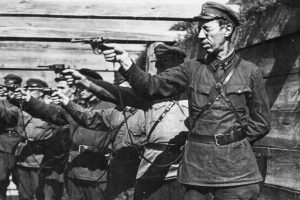
by Lev Tsitrin
The brutality of Russian forces that was revealed in places like Bucha, where male population was all but exterminated, is being explained by military experts as a deliberate tactic to break the Ukrainian’s morale, and their willingness to fight. While not unreasonable, this explanation has a basic problem: to intimidate, the brutality has to be broadcasted far and wide — which may well produce an exactly opposite effect: revulsion in the wider world (accompanied by accusations of war crimes), and inflaming Ukrainians even further (if this is even possible).
So perhaps, something totally different is going on here. Can brutality be a simple result of the righteous rage of Russian soldiers, vented on those whom they see as devilishly perverted?
After all, something very similar happened in Russia in 1930s. By deliberate state policy, Russia’s agrarian society became heavily industrialized, its peasantry herded into collective farms. This industrial and agricultural revolution caused unimaginable suffering (several million peasants starved to death in the process), but Soviet Government saw it as a great success. The people who died had bourgeois ideology, they were perverse individualists who wanted privately-owned land and did not care for collectivist, Communist future of humanity. Good riddance! So all was well — except that evil capitalists, fearing that Soviet successes would cause the proletariat and peasantry of their own countries to revolt and expropriate private property for the sake of the historically inevitable Communism, conspired to stymie the progress of the USSR, and enlisted saboteurs to hinder Soviet successes. The stronger the Socialist progress, the more intense the class struggle would became, the Party declared. The saboteurs in factories, farms, and the government — labeled “enemies of the people” — had to be discovered, put on trial, and eliminated.
Needless to say, once the Party pointed the way, the technicalities were easy. NKVD — the predecessor of the KGB — rose to the occasion, finding and arresting the “enemies of the people” by their millions, either sending the perverts who were hell-bent on stopping the progress of History to labor camps, or just killing them, with or without a trial. The brutality with which NKVD agents acted became notorious — Solzhenitsyn, Natalya Ginsburg, and other survivors described it in a bone-chilling detail.
Fast-forward to the present — and the story of today is essentially a carbon-copy of what happened some ninety years ago. Again, Russia has made a huge economic leap forward from its miserable state in 1990s. And again — as Russia’s President Putin explained when ordering the “special military operation” in Ukraine — further progress was endangered by the conspiracy of world powers headed by the US, which primed Ukraine as a bridgehead for attacking Russia militarily, or degrading it morally — and that, whether Russia acted preemptively or not, the West would have imposed sanctions on it anyway, just to stymie its progress. And again, there were saboteurs — the “fascists” in Ukraine, hell-bent on stymieing Russia, this flagship of pure morality unsullied by Western perversion, this hope of the world! And again, there had to be a rescue — this time, Russian army had to clear out the base conspirators.
The difference between the two events separated by almost a century is merely in labeling, and nothing else: the flagship of progress, USSR back then, has become Russia; the “social progress” has become “national progress,” the nefarious motivation for the urge to stymie Russia’s progress turned from blocking Communism to blocking the restoration of the Empire, though the dark forces doing the stymieing remain the same; their devilish stooges are now called “Ukrainian fascists” rather than “enemies of the people” — and the angelic forces called to stop the dark conspiracy are not the NKVD, but the Russian army.
So, all things being the same, why be surprised at the actions of the righteous saviors of civilization? Their rage at the “fascists of Ukraine” is exactly the same as the rage of NKVD at the “enemies of the people”, and the methods by which cleansing is achieved, are exactly the same: the uncomprehending unfortunates caught in the net are treated with a bullet to the head, after being put through torture — which is all that the “fascists,” deserve after all, just as the “enemies of people” did.
The more things change, the more they stay the same. Things changed a lot in Russia since 1930s — the Soviet Union collapsed and fell apart, Russia became prosperous and, to all appearances, democratic — yet somehow, it managed to claw its way right back to where it was ninety years back. There is plenty of nostalgia for heroic past in Russia, but the past it found itself in upon invading Ukraine is far from heroic. The “fascists” it fights in Ukraine are as chimeric as were the “enemies of the people.” But hate and brutality with which those chimeras are being suppressed are every bit as vicious and terrifying they were back in 1930s.
- Like
- Digg
- Del
- Tumblr
- VKontakte
- Buffer
- Love This
- Odnoklassniki
- Meneame
- Blogger
- Amazon
- Yahoo Mail
- Gmail
- AOL
- Newsvine
- HackerNews
- Evernote
- MySpace
- Mail.ru
- Viadeo
- Line
- Comments
- Yummly
- SMS
- Viber
- Telegram
- Subscribe
- Skype
- Facebook Messenger
- Kakao
- LiveJournal
- Yammer
- Edgar
- Fintel
- Mix
- Instapaper
- Copy Link






